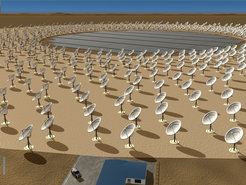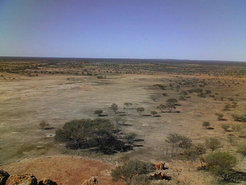Australia and Southern Africa short-listed for Giant Radio Telescope
Astronomers met in Germany to decide upon the SKA site
The decision was made at the 16th meeting of the SKA International Scientific Steering Committee in Dresden (Germany) from August 28-30 2006, following advice from an external committee of 7 scientists from 5 countries that examined the four site bids.
"Both Australia and Southern Africa can meet the full range of requirements for the SKA," said Prof. Richard Schilizzi, International SKA Project Director, in announcing the decision today in Dwingeloo, The Netherlands.
The SKA will be a set of thousands of antennas, not a single giant instrument, spread over 3000 kilometres, but with half of the antennas located in a central region 5 kilometres across. The SKA will be 50 times more sensitive than the most powerful radio telescopes we now have. It will peer deep into the cosmos to pick up signs of the first stars and galaxies to form after the Big Bang; it will trace the effects of the mysterious Dark Energy that is driving the Universe apart at an ever increasing speed; and it will map out the influence of magnetic fields on the development of stars and galaxies. Observations of pulsars will allow the SKA to look for the effects of gravitational waves from merging massive black-holes at the centres of other galaxies. If there are extra-terrestrial intelligences out there in the Milky Way with airport or ionospheric radars, the SKA will detect them.

For Australia, the core site is proposed to be at Mileura station, about 100 km west of Meekathara in Western Australia. Other dishes would be distributed over the Australian continent with the possibility of extension into New Zealand. In Southern Africa, the central location would be at the Karoo site in the Northern Cape region of South Africa, about 95 km from Carnarvon, with further dishes located in South Africa itself and in neighbouring African countries - Botswana, Namibia, Mozambique, Madagasgar, Mauritius, Kenya, and Ghana.
A key requirement of the core site is that there must be a very low level of man-made radio signals, because interference will mask the faint cosmic radio waves the telescope is designed to detect. "Furthermore, South Africa and Australia are both making excellent progress towards protecting these unique environments with radio-quiet zones that will limit the use of radio transmitting equipment" said Prof. Phil Diamond, past-chair of the International SKA Steering Committee.

Both the Australian and Southern African sites can see much of the same sky as other major ground-based optical, infrared and sub-millimetre telescopes and both have a good view of the southern sky, which is where the centre of our Galaxy goes overhead. Both also have stable ionospheric conditions, which is important for the low-frequency observations the SKA will make.

China and Argentina/Brazil also bid to host the SKA. Both sites were also considered exceptional sites for radio astronomy, but failed to meet at least one of the broad range of exacting requirements for the Square Kilometre Array. The proposed Chinese site would place unacceptable restrictions on the placement of the central elements of the SKA and the joint Argentinian/Brazilian proposal was eliminated because the ionospheric conditions above South America would limit the SKA's performance at low frequencies.
Further analysis of the short-listed sites will now be carried out, with the final decision on which of the two sites will host the SKA expected towards the end of the decade.
"The SKA will be a breakthrough for the investigation of the universe and the development of radio astronomy. In Europe, the MPIfR with partner institutions in the European Consortium is gearing up to play a substantial role in this global project", says Prof. Anton Zensus, chairman of the European SKA Consortium.


